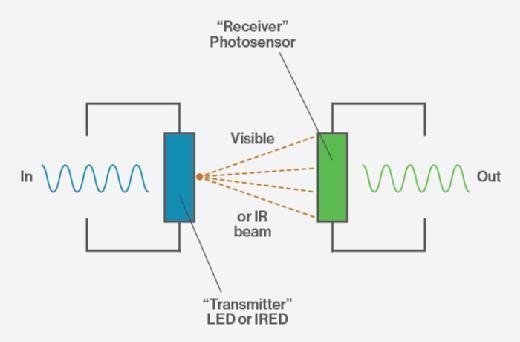optoisolator (optical coupler or optocoupler)
What is an optoisolator (optical coupler or optocoupler)?
An optoisolator (also known as an optical coupler, photocoupler, optocoupler) is a semiconductor device that transfers an electrical signal between isolated circuits using light.
These electronic components are used in a wide variety of communications and monitoring systems that use electrical isolation to prevent high voltage emitters from affecting lower power circuitry receiving a signal.
How do optoisolators work?
The schematic of an optoisolator consists of an emitter, in this case an infrared light-emitting diode (IRED) or laser diode for input signal transmission and a photosensor (or phototransistor) for signal reception. In this way, the input signal can either generate electric energy or modulate an electrical current that's coming from an electronic device or other power supply.
When the input current is applied to the LED photodiode (a common type of photosensor), infrared light is produced and passes through the material inside the optical isolator. The beam travels across a transparent gap and is picked up by the receiver, which acts as a converter. Using signal isolation, the sensor is able to transform the modulated light back into an output signal.
The input side of optoisolators could be a photoresistor, a photodiode, a phototransistor, a silicon-controlled rectifier or a triac. An optocoupled solid-state relay contains a photodiode optoisolator that drives a power switch on the output side, usually a complementary pair of MOSFETs.
Why are optoisolators important?
Electronic equipment, such as microcontrollers, printed circuit boards and transformers are subject to voltage surges from radio frequency transmissions, lightning strikes and spikes in the power supply volts.
Photoresistor-based optoisolators were first used in 1968 in the audio and music industries to avoid disruption in equipment such as guitar amplifiers. Optoisolators offer a safe way to make high-voltage components and low-voltage devices work together in a proportional way.
The optoisolator is enclosed in a single device (see image) and has the appearance of an integrated circuit or a transistor with extra leads. Through automation, organizations can use optocouplers to isolate low-power circuits from higher-power output circuits and to remove electrical noise from signals.

What types of uses do optoisolators have?
Optoisolators are most suited to isolation voltage from digital signals, but they can also be used to transfer analog signals.
The isolation of any data rate of more than 1 megabits per second (Mbps) is considered high speed. The most common speed available for digital and analog optoisolators is 1 Mbps, although 10 Mbps and 15 Mbps digital speeds are also available.
Optoisolators are considered too slow for many modern digital uses, but researchers have created alternatives since the 1990s.
In communications, high-speed optoisolators are used in power supplies for servers and telecom applications -- Power over Ethernet (PoE) technology for wired Ethernet LANs, for example. Optoisolator components can also protect Ethernet and fiber optic cables from electrical surges. In VoIP phones, electrical signals can be isolated using a transistor output optocoupler.
Although no longer common, where Modems are used to connect to telephone lines, the use of optoisolators allows a computer to be connected to a telephone line without risk of damage from electrical surges or spikes. In this case, two optoisolators are employed in the analog section of the device: one for upstream signals and the other for downstream signals. If a surge occurs on the telephone line, the computer will be unaffected because the optical gap does not conduct electric current.







